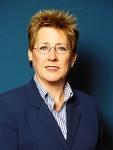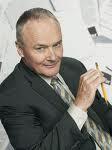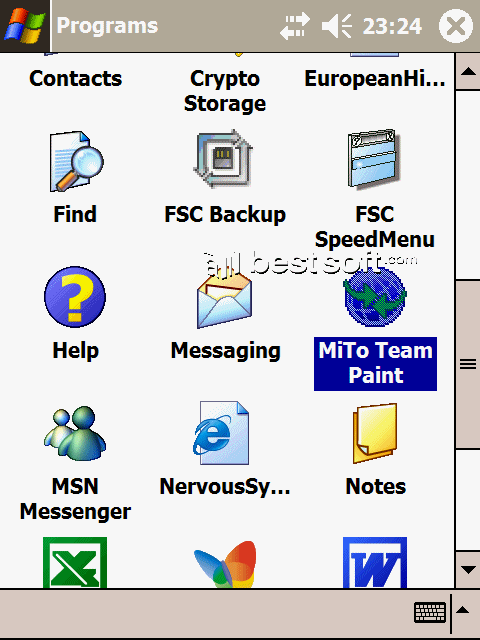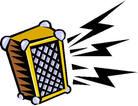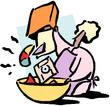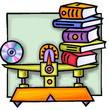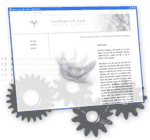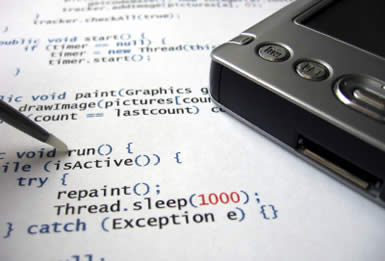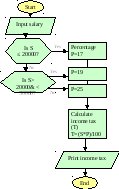
- •А.Д. Музафарова а.Г. Ковалева
- •Vocabulary practice section 1
- •Vocabulary practice section 2
- •Vocabulary practice section 3
- •This week: software
- •Vocabulary practice section 1
- •Vocabulary practice section 2
- •Internet: Voice recognition takes off
- •Programming languages.
- •Vocabulary practice section 1
- •Vocabulary practice section 2
- •Int — international organization
- •Vocabulary practice section 3
- •The 15 enemies of the Internet
- •Internet crime
- •Vocabulary practice section 1
- •Vocabulary practice section 2
- •Vocabulary practice section 3
- •How a virus infects a program
- •Vocabulary practice section 1
- •Video Games
- •Vocabulary practice section 2
- •Vocabulary practice setion 3
- •Vocabulary practice setion 4
- •Twitter's transmitters
- •Vocabulary practice section 1
- •Good Web Design? What Is It?
- •Vocabulary practice section 2
- •Vocabulary practice section 3
- •Top Five Ways to Make Your Site More Popular
- •1. Strong Hosting
- •2. Optimize Your Website
- •3. Take Advantage of Social Media Optimization
- •4. Get Your Visitors Involved
- •5. Emphasize Usability in Your Design
- •You’ve been in graphics too long if…
- •Internet
- •Web design
This week: software
Software technology is getting more complicated. Developers have to cut through a jungle of computer languages, operating environments, and shifting standards to choose how they'll create their software. It's not an easy job. Software purchasers will have to live with the results for years to come. Which advances in software technology will prevail? Which ones will be just a flash in the pan?
Four well-known software developers were chosen and asked to talk about current and future trends in software technology. Their comments reveal some common and diverse themes.
They were asked if they thought that software purchasers are getting what they need. What should developers be doing differently to give purchasers a better product?
|
|
Mary Evans ‘In general, I think people are getting what they want -there are a lot of creative things being done with paint software, word processing, DTP (desktop publishing) systems, and the like. Do users want more? Of course! Users will always want more. The computer is an incredibly powerful tool, and any software that makes it easier, faster, more creative, or more cost-effective will inevitably be in demand. But I'm generally optimistic about the way things are going at the moment. I think most of the major software manufacturers are able to read the market quite well.’ |
|
|
Gerry Harper ‘I'm afraid I completely disagree with Mary. I just don't think that software purchasers are getting the technical support they need. While the products are getting more and more complex, and more and more expensive, it seems that support is starting to be thought of as an additional business opportunity. More generally, I've thought for some time that applications are getting too big and that they're trying to do too much. Yes, they're versatile and powerful, but they're also often overwhelming. I think what we need are simple little programs that are easy to understand and use, and that work together to accomplish more complex tasks.’ |
|
|
Matt Andrews ‘I really can't agree with that. To imagine we can just go back to "simple little programs" just ignores the complex needs of many of today's software users. No. I'm sure that you can't stop progress. Suppliers know what their customers want - they just can't supply it quickly enough. I've studied the market very closely, and I've found that purchasers' needs seem always to exceed the capability of the available software by a constant time-frame of about six to twelve months.’ |
|
|
Bob Bolton ‘I think users are getting what they want, their needs fit the off-the-shelf application. Specialized software is usually so specific that it should be written in-house for businesses. Developers should add features that the customer needs, not what they think customers want. Some effort should be made to get feedback from the users before making an upgrade so that the proper features are added.’ |
Notes:
a flash in the pan - a success that lasts only a short time and is not repeated
off-the-shelf - mass-produced; not made according to the individual needs of the customer
2. Each of the following comments from the text is followed by two paraphrases. Decide which paraphrase (a or b) is closer in meaning to the original comments. Remember to look at the comments in their original context.
|
1. ‘Developers have to cut through a jungle of computer languages, operating environments, and shifting standards...’ a. The huge number of languages, environments, and standards makes life difficult for software developers. b. Software developers have to act to reduce the number of languages, environments, and standards |
|
which currently exist.
2. ‘Their comments reveal some common and diverse themes.’
a. They talk about ordinary and wide-ranging topics.
b. They agree about some issues, but disagree about others.
|
|
3. ‘I think most of the major software manufacturers are able to read the market quite well.’ a. Most software manufacturers understand what consumers want. b. Most software manufacturers know how to influence users to buy more their products. 4. ‘...it seems that support is starting to be |
thought of as an additional business opportunity.’
a. Increased technical support is a means of making software more attractive to businesses.
b. Software manufacturers are using the fact their products are complex to start selling technical support to their customers.
5. ‘... purchasers' needs seem always to exceed the capability of the available software by a constant time-frame of about six to twelve months.’
a. It takes about six to twelve months for purchasers to understand fully the software they buy.
b. The software customers want now what will only become available in about six to twelve months.
SPEAKING/WRITING PRACTICE SECTION
1. Make a report on one of the following topics.
1. Prove main software characteristics (software is developed and engineered, software doesn't "wear-out", most software continues to be custom built) using the information about different types of software and programming languages.
2. Find the details of Windows/ Linux/ Mac software development.
3. Give description of main characteristics, functions and opportunities of
|
|
|
2. Describe pictures. Do they express the meaning of word processing and software? Why?
|
Two more ways of word processing |
How to use software |
3. Find your own pictures that can characterise the meaning of main terms from this unit? Give comments.
4. Find/make any type of spreadsheets or databases. Describe them.
5. Describe the pointed elements of the picture. Speak on their functions.

6. Write a letter to your friend. Tell him/her about your future plans for summer. Print it. After that using different features of word processing make these changes:
use another typeface at 14 point, make the text bold, change alignment, insert hyperlink and print the letter. Compare the variants. Which do you like more?
FUN AND GAMES SECTION
1. Word association: missing links
Each of the sets of words below can be linked by one other word. What is the missing word? Give definitions to the words. What other collocations with these words do you know?
|
SYSTEM |
|
TESTING |
|
APPLICATION |
|
LICENSE |
|
PROGRAMMING |
|
HARDWARE |
2. Solve the clues and complete the puzzle with words
|
1. on a computer screen, a row of icons 2. an official document which gives you permission to own, do or use something, usually after you have paid money and/or taken a test 3. a single instruction given to a computer which produces a set of instructions for the computer to perform a particular piece of work 4. a computer program, used especially in business, which allows you to do financial |
|
calculations and plans
5. a list of choices that can be made to appear on a computer screen
6. a person whose job is to produce computer programs
7. a computer program that is designed for a particular purpose
8. the instructions which control what a computer does; computer programs
9. combine two or more sorted sequences of data into a single sorted sequence
10. a computer program that watches what people do with their computers, and then sends that information over the Internet
HUMOR SECTION
What does each of the cartoons imply? Why is it funny, in your opinion? Explain its humour.
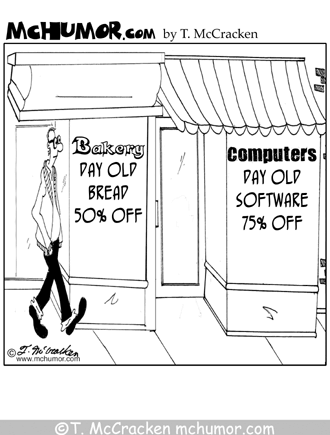
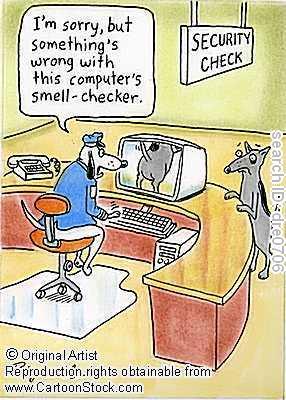
|
|
PROGRAMMING |
KEY INFORMATION SECTION 1
|
|
|
|
Programmingis the process of preparing a set of coded instructions which enables the computer to solve specific problems or to perform specific functions. The essence of computer programming is theencodingof the program for the computer by means ofalgorithms. The thing is that any problem is expressed in mathematical terms, it contains formulae, equations and calculations. But the computer cannot manipulate formulae, equations and calculations. Any problem must be specially processed for the computer to understand it, that is -codedor programmed.
The programsare lists of instructions that will be followed by the control unit of the central processing unit (CPU). The instructions of the program must be complete and in the appropriate sequence, or else the wrong answers will result.The purpose of programming is to create a program that demonstrates a certain desired behaviour (customization). Said another way, programming is the work of transforming requirements into something that a computer can execute.
Steps in writing a program
The phase in which the computer programs are written is called the development phase. To write a program, software developers usually follow these steps.
First they try to understand the problem and define the purpose of the program.
Then they design a logical planof the program. There are two common techniques for planning the logic of a program.
|
A flowchart to calculate income tax
|
The first technique is flowcharting. Aflowchartis a plan in the form of a graphic or pictorial representation that uses predefined symbols to illustrate the program logic. It is, therefore, a "picture" of the successive logical steps to be performed by the computer. Each of the predefined symbol shapes stands for a general operation. The symbol shape communicates the nature of the general operation, and the specifics are written within the symbol. A plastic or metal guide called atemplateis used to make drawing the symbols easier. The second technique for planning program logic is called pseudocode - an imitation of actual program instructions. It allows a program-like structure without the burden of programming rules to follow. Pseudocode is less time-consuming for the professional programmer than is flowcharting. It also emphasizes a top-down approach to program structure. |
Pseudocode has three basic structures: sequence,decision, andlooping logic. With these three structures, any required logic can be expressed.
Next they write the program instructions. This is calledcoding. The instructions will be written on a form called acoding form. The instructions we write will be recorded in a machine-readable form. The instructions must be written according to а set of rules that are the foundation of aprogramming language.
When the program is written, they testit: they run the program to see if it works and use special tools to detectbugs, or errors. Any errors are corrected until it runs smoothly. This is calleddebugging, or bug fixing. Debugging is a very important task in the software development process, because an incorrect program can have significant consequences for its users. Some languages are more prone to some kinds of faults because their specification does not require compilers to perform as much checking as other languages.
There are two kinds of errors or bugs with which programmers must deal.
The first type is the coding error. Such errors aresyntax errorsthat prevent the language processor from successfully translating the source program to object program code. The language processor identifies the nature and the location of the error on the source program listing, so these errors are relatively easy to find and correct.
The second type of bug is the logic error. The computer program can be successfully translated, but the program does not produce the desired results. These errors are generally much more difficult to find and to correct than are coding errors. Logic errors can be avoided through careful planning of the program logic.
Finally, software companies write a detailed description of how the program works, called program documentation. They also have amaintenanceprogram. They get reports from users about any errors found in the program. After it has been improved, it is published as an updated version.

